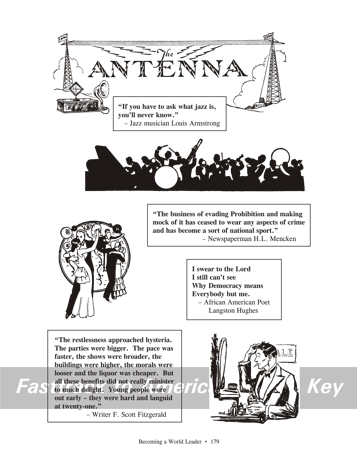| Fasttrack
to America's Past Teacher Key |
|
| Fasttrack
to America's Past Teacher Key |
|
 Page 178  Page 179 Page 179 |
Pages 178
& 179 - Talk of the Twenties The pictures 1. A tri-motor (three engine) airplane flies over a growing industrial city on the shore of a lake. Cities and industry continued growing in the prosperity of the 1920s. 2. An early electric clothes washing machine, called a wringer washer. Electric appliances became much more common in American homes in the 1920s. The washing machine used the rollers mounted on the top to squeeze the wash water from the clothes. 3. Two women in an automobile. Women were stepping out of traditional roles and enjoying a new sense of freedom in the 1920s. The car helped make that freedom more accessible than ever. 4. Electric power lines being hooked up. Electric power continued growing as a vital energy source across America during the 1920s. 5. An antenna and radio receiver of the 1920s. Radio grew into an immensely popular entertainment medium in the decade. 6. A band like those that became popular in the 1920s. The new sound of jazz spread into the popular culture of America. 7. Dancing couples of the "Roaring Twenties." Big city night clubs and private parties offered many diversions to those wealthy enough to keep up. 8. A college man preparing for a night on the town. A Yale banner hangs in the background. Young people were often caught up in the fast life and excitement of the 1920s. The quotes 1. "America's present need..." Many Americans of the 1920s were eager to leave the turmoil of World War One and radical ideas about social reform behind them. Warren G. Harding, running for president, captured that desire for what he called "normalcy" in this well known quotation. 2. My candle burns at both ends...These lines by poet Edna St. Vincent Millay reflect the desire of many Americans in the 1920s to throw off traditional restraints and live life "in the fast lane." The poet celebrates the excitement it brings, while recognizing that it may not last long. 3. "The business of America..." The 1920s was a boom
period for American
business. That suited President Calvin Coolidge - and many other
Americans
- just fine. Conditions on many farms and in some businesses were
not good, however, and the U.S. economy had a dramatic crash at the end
of the decade. The Scopes Trial of 1925 became a national spectacle, thanks in part to radio broadcasting. A teacher in Tennessee named John Scopes violated a law in that state that banned schools from teaching about Charles Darwin's theory of evolution. The trial revealed the split in America between people with traditional religious views and those who embraced new ideas about science and society. 5. "If you have to ask what jazz..." Louis Armstrong was one of the greats of jazz. His comment suggests that anyone unfamiliar with jazz must be hopelessly out of touch. Jazz spread into popular music during the decade in a big way. 6. "The business of evading..."Prohibition outlawed alcohol, but millions of Americans ignored the law. The defiance of Prohibition was so widespread that many considered evasion of the law almost a sport. H.L. Mencken was a famous newspaper writer known for his wit and sharp observations of American society. 7. I swear to the Lord...This short poem by poet Langston Hughes highlights the fact that a great racial divide still kept blacks out of the mainstream of American society. Hughes, an African American, was part of the Harlem Renaissance. 8. "The restlessness approached hysteria..."F. Scott Fitzgerald was a famous novelist who joined in, and wrote about, the excesses of the 1920s. Here he makes a point about the emotional cost of the "Roaring Twenties" - young people grew up too fast for their own good. |
|
Copyright Notice
Copyright 2018 by David Burns. All rights reserved. Illustrations and reading selections appearing in this work are taken from sources in the public domain and from private collections used by permission. Sources include: the Dover Pictorial Archive, the Library of Congress, The National Archives, The Hart Publishing Co., Corel Corporation and its licensors, Nova Development Corporation and its licensors, and others. Maps were created or adapted by the author using reference maps from the United States Geological Survey and Cartesia Software. Please see the home page for this title for more information. |